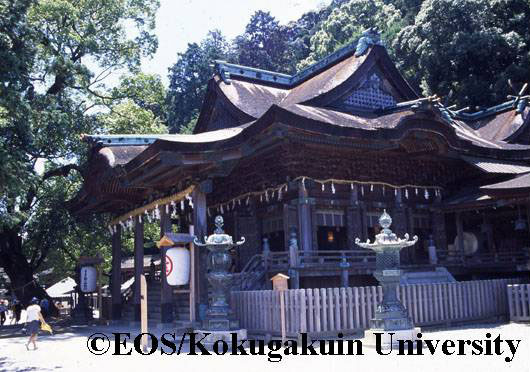- トップ
- Encyclopedia of Shinto
- Uminokami
Encyclopedia of Shinto
| Main Menu: | |
| Links: |
詳細表示 (Complete Article)
| カテゴリー1: | 2. Kami (Deities) |
|---|---|
| カテゴリー2: | Kami in Folk Religion |
| Title | Uminokami |
| Text | [Umi no kami] "Kami of the sea," a tutelary of the ocean and ocean travel. Believed to live in the sea or the "other world" at the bottom of the sea, the umi no kami is a nature deity believed to have dominion over ocean winds and waves, the tides, and rains. It was anciently believed that if the sea kami were angered, it would bring high winds and disturb the activity of fishing, but if properly placated, it would assure fishermen safe passage for their boats, and bountiful catches of fish. The sea was called wata or wata no hara (the ocean plain), with the result that the sea kami was commonly referred to as Watatsumi. According to the myths of the Nihongi and Kojiki, the sea kami Watatsumi appears as the offspring of Izanagi and Izanami. In the myth of the "sea blessing" (umisachi) and "mountain blessing" (yamasachi), it was the deity Watatsumi living in his undersea palace who assisted Hohodemi (Yamasachibiko) by retrieving the fishhook belonging to Hohodemi's elder brother Umisachibiko. The ocean tutelaries worshipped at the shrines Sumiyoshi Jinja and Munakata Taisha are believed to be related to this same Watatsumi of myth. On the other hand, the sea kami which served as the common people's objects of supplication for safe ocean passage and abundant catches on the sea had little relation to the kami of myth. For example, the popular kami called ryūjin ("dragon deity") was the product of a combination of Chinese dragon motifs with the snake worshiped in a local water-deity cult. The identification of ryūjin with sea kami is also reflected in the taboo (imi) against dropping metal objects into the sea, based on the belief that dragons and snakes loathe such objects. The cult of the dragon deity as a sea kami is believed to have been particularly spread by practitioners of the mountain religion called Shugendō. In the form of a snake, the kami of the Konpira Shrine was worshiped by sea-farers who revered the shrine's deity as a tutelary who would protect them from the perils of the sea. The kami Ebisu is likewise worshiped as a sea kami by fishermen who believe the deity is responsible for "luck" in fishing. In Kojiki and Nihongi, sea kami are portrayed as living in another world called Tokoyo or Watatsumi, while in Okinawa such kami are thought to live in palaces in paradisical lands called Nirai and Kanai, located far beyond or under the sea. Such lands are viewed as being accessible to human beings, and legends can be found widely throughout Japan relating stories of individuals led to undersea dragon palace in return for aiding sea turtles or fish, who were considered servants of the sea kami. -Suzuki Kentarō |






